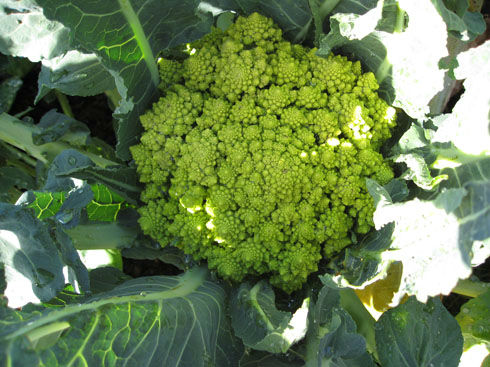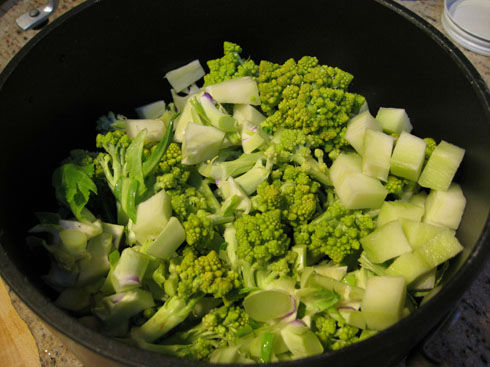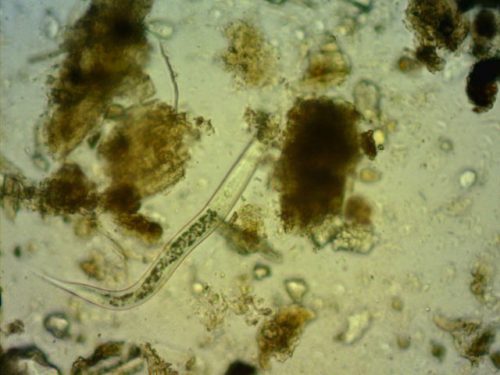Growing new varieties each season keeps the garden interesting. Since we focus on heirlooms and open pollinated varieties here at Gardenerd, our choices are not new, but rather newly discovered. After a slight seed debacle last year where we grew seeds from an (unnamed) seed company that purchased Romanesco seeds from an untrustworthy supplier, resulting in Romanesco that looked nothing like Romanesco, we tried again this year with guaranteed seed.
What a success!

A Romanesco head just starting to separate, about 6″ in diameter
Romanesco broccoli is a bright chartreuse addition to the garden in fall (in warmer climates) or cool spring. Its leaves are Jurassic in size, so it needs some room (that said, we still planted ours 12″ apart). The leaves are edible, but you may want to choose smaller leaves or cut out the stem of larger leaves.
Like cauliflower, it can be tricky to get the plant to form a head. We have broccoli, cauliflower and Romanesco growing in the same bed, and our broccoli and Romanesco headed up, but the cauliflower didn’t. We’re still holding out, but the outlook isn’t good. Research shows that too much nitrogen can cause leafy growth with no head, but our garden tends toward nitrogen deficiency, so I’m guessing we need more phosphorus for better fruit and flower production.
Do the Math
In addition to being a beautiful addition to the garden, Romanesco broccoli provides a math lesson for students and adults who don’t get cross-eyed thinking about math. It’s a great example of Fibonacci numbers and fractals. Fibonacci numbers are a series of numbers, invented/discovered by Leonardo Fibonacci, where “each number after 1 [is] equal to the sum of its two predecessors.” That quote comes from a great website that uses Romanesco and sunflowers (you could use pineapples too) to explain the series:
http://scienceray.com/mathematics/leonardo-fibonacci-a-natural-growth-of-mathematics/
Harvesting
To harvest Romanesco, pick the entire head before it starts to separate (not like our photo above, which was a day or two late). Heads should feel tight and compact when you squeeze them. Picking late doesn’t reduce the flavor of the broccoli, it just opens it up to aphid infestation. One of the beautiful things about Romanesco is that it is so tightly formed, aphids can’t get in.
Cooking
Romanesco is reported to be less bitter than cauliflower and broccoli. We found ours to be very sweet and delicious. Since it was our first harvest, we prepared it simply to experience the flavors.

Chopped stems and florets drizzled with olive oil, salt, pepper, red pepper flakes and a little garlic powder
Put about a 1/4″ of water at the bottom of the pan, cover and bring to a simmer. Set your timer for 5 minutes then serve immediately.
We served it up with some hoisin-glazed tempeh and a brown rice / pearled barley combo.

Romanesco is a beautiful heirloom that can enhance any garden. It’s also a great conversation piece. If you’ve grown it, share your experiences with us here.




Pingback: YouTube: Grow Romanesco - The Underappreciated Brassica - Gardenerd
Hi! I’m just wondering if Romanesco Broccoli gets true seed or if it’s a cultivar that has to either be propagated or has to have a new packet of seed each year? I’ve read that it’s a hybrid, but a 500-year-old hybrid. So I’m confused. Can you grow a well-formed head until it goes to seed and save the seeds? I’m new to growing any brassicas. Thank you for any information you can give!
It can be hard to find an open pollinated Romanesco variety but I have seen them out there. You can save seeds from those. You might check Victory Seeds, or Reimer Seeds. Both carry open pollinated varieties. It was stabilized long ago, but most seed companies still sell hybrid cultivars instead of OP.
I planted romanesco from seed back in the summer here in Eastern Oklahoma. They keep growing and growing and I thought they would never flower. I didn’t know they can survive freezing temperatures because they are huge plants now and have started to form heads in the past 2 weeks in this freezing 32 below morning temps. Some are ready to harvest.
Congrats! Most brassicas, including Romanesco, benefit from frost. They become sweeter after that. Enjoy your harvest!
Hello! I just realized my (what I thought was) cauliflower is actually Veronica Romanesco! There are many tiny leaves between the curds and I’m wondering if this is normal in Romanesco, or if leafy curds can be cured by tying the leaves around the head to blanche it? First time gardener here and I’d love to share a photo of what I’m talking about. Many thanks!
Leaf growth between curds is usually (for me anyway) a sign on some stress during it’s growth period. Sudden heat, not enough nutrients in the soil, etc. You can still eat the harvest and even the leaves if you want to. But I don’t think it’s worth trying to reverse or curtail the habit it has developed. Romanesco, like cauliflower, is a heavy feeder, so make sure you have plenty of compost, worm castings, and nutrients in the soil (test first) next time. See how it goes!
Thanks so much Christy! I’ve used seaweed emulsion to feed it but I’ll try to side dress it with some compost tonight. Really appreciate the response!
I am a first time gardener from Kansas. I went to an Amish greenhouse and purchased what I thought were broccoli plants. Built raised garden beds filled with soil and mushroom compost. Planted the three small plants that I purchased, and they took off growing! Huge beautiful plants. But I noticed a couple of days ago in June, that they are forming heads. But it’s obviously not broccoli like thought that it was! So I did some research, and it is romanesco!!! I’ve never even heard of this plant before! I’m a little disappointed that I won’t have broccoli this year, but am excited to learn about romanesco!
I think you’ll enjoy the Romanesco. It has a broccoli flavor, but really fashionable flair at the dinner table.
Hi I’m growing Romanesco for the first time in very large containers, the heads are growing nicely but they’re turning red, can you tell me what is going on with them?
Much like cauliflower, exposing romanesco to sunlight will cause it to turn colors. Use a clothes pin to secure the leaves closed over the head. This “blanches” the head and helps maintain the proper color.
Greetings from Chandler, AZ! I have some almost ready for harvest! They are so beautiful!
Greetings diggers, from a North Wales allotment where, this year, feeding throughout the growing season with soluble lime and miraclegro, together, has yielded clubroot-free plants each with a beautifully formed head, not a single no-show! Annual climatic variations are naturally a factor, stress is possibly another: coincidentally, to counter downy mildew, I sprayed larger leaves with 50% solution of whole milk, killing both leaves and mildew (perhaps something else other than milk accidentally also in the mix). Suspecting the plants were possibly better off without them, I removed the affected leaves. Having all but written them off, a few weeks later I was delighted to see heads on all plants and it’s turned out to be the beast crop ever. Two main reminders/suggestions then: 1) brassicas thrive on lime, which, amongst other things, helps them resist club root; adding soluble lime to liquid feed worked for me. 2) stress often brings plants into flower but there are almost certainly kinder ways to apply stress than my accidental defoliation – perhaps try breaking all but the small leaves off of a few plants as they approach maturity !
Thanks for sharing, Richard. We already have very alkaline soil here, so lime is not recommended for those with a pH above 7. But glad to hear it boosted your growth in acidic soils. A word about Miraclegro: it’s a synthetic nitrate fertilizer that bonds with water molecules and travels down into the water table. We prefer organic options over synthetic since some ingredients in organics feed soil microbes as well as the plant, and are present in small enough quantities to prevent runoff and nitrate pollution of waterways. Lastly, crop rotation of brassicas will also help prevent club root. Try a 3-year rotation and that should do the trick.
I started with a seedling from a local garden shop, planted it in my raised garden bed around mid-May In Eastern Mass USA. I have a beautiful head and huge leaves. Looking forward to roasting the leaves along with the head. Not sure I did anything special.
I was starting to give up on my Romanescu when today (November 17th 2018) i spotted a small head of about 2-inches in 3 separate plants. I live in the south of England. Getting very excited about picking them but not sure whether to wait until they get a bit bigger or harvest them before it’s too late… any advice?
Hi Virginia, congrats on your Romanesco. I know you are fast approaching the dead of winter there, but if you can protect them so they can grow a little larger, I would. The heads can grow to 5-8″ in diameter if you let them. If you start to see the curds separating, then pick it. Otherwise give it some time to grow larger. If the tips or edges start turning purple-ish, go ahead and pick. They are pretty frost tolerant, but we don’t want damage.
I planted romanesco twice and get this huge 4 ft plant and no head. Only fertilized once in early spring to get it going. Totally perplexed!
Hi Melanie, because it is technically a flower-producing plant, it does need food mid-season before heading up. I usually mix worm castings and compost (and fertilizer if growing in a container) to help boost growth mid-season. Kelp meal and sea-bird guano help with fruiting and flowering. Try that this fall and see what happens.
Same here!! Tall, beautiful plants.. but no head. I planted them since summertime, so I guess i have to give up on them. ☹️
you could “wait and see”. A few years ago we had All the year Round cauliflower which took nearly 18 months to head up and were monsters. We live in SWEngland..
Jennifer, thanks for sharing your story. It’s good to hear that good things came to those who waited. Glad it worked out.
We compost all our organic scraps and out of the blue a single Romanesco popped up in our garden! The plant grew to one meter tall! We have never bought or eaten one before so who knows where the seed came from. Thanks to the guidance of your site, we have just picked it and will probably try your recipe to enjoy our first experience of this majestic plant 🙂
Thank you for the information. So… after harvesting (one and done) do you pull the plant from the soil?
In the case of Romanesco, yes. Pull the plant. It won’t come back.
Thank you!
Hi! After harvesting, will the plant produce another head or is it done?
No, romanesco is “one and done” like cauliflower.
Hi there
We love e your site! We are harvesting our romanesco today! In Tracy ca.
Charlotte
Glad you like the site, Charlotte. And congrats on harvesting your Romanesco today! Enjoy it!
I learned this year that cauliflower tends to turn a purple color when it forms a head in hot weather. That’s exactly what happened in my garden this spring, a big head turned a very noticeable purple during very warm weather. It perplexed me too, because I planted purple cauliflower in another location and the color wasn’t deep enough to be a purple variety. Perhaps being from the same family, Romanesco also goes purple in heat?
I’ve seen Romanesco darken on the edges once, but I can’t remember what the circumstances were with the weather. It looked like sunscald, to a degree. Ordinarily, though, this hasn’t happened because we grow it in the fall when temperatures are cooler.
Hi there ? i know I’m a tad late to the conversation, but i came across your page while looking for asvice on when to harvest my romanesco broccoli. I just picked it as it was a bit loose (you said it should be tight) and the florets were starting to get a purple tinge to them (someone else here had a pink thing going on with theirs – weird!). Anyway, i planted my 10 broccolis waaaaay to close together so they’ve all struggled for space and light, so it’s amazing any have headed. This is my first time growing broccoli. I planted seedlings early April (early autumn Australia), so this one took 4 months, but all my others are only tiiiiiny heads so far, so i shall be waiting for a while longer, & after reading all these posts i shall persevere with patience! I don’t know if i can attach a pic to my comment, but just wanted to say thanks so much for your info and happy gardening ? paula xo
Just some more feedback for everyone-
I started my romanesco from seed in April, put it in the ground at the end of May and it grew and grew past 2 feet tall by July. It was attacked by worms constantly even though I sprinkled with flour and cayenne weekly but one of my plants stuck i out and just this week I have a head on it! That’s 7 months and… Success!
From Coatesville, PA
A hard-won victory, indeed! Congratulations on your 7-month Romanesco. Try floating row cover to keep those cabbage worms at bay next time and I think you’ll find it an easier road. Persistence is key, and you’ve obviously got plenty of it.
I planted my romanescro as a seed started outdoors in late march. Will I get anything this year? The plants are about 3 ft tall but no sign of a head.
Hi Ann, if it’s 3 feet tall then it most likely is bolting, but it probably won’t set a head. I recommend starting the seeds indoors and growing them in the fall instead of spring if your climate allows. Like other brassicas, romanesco likes cool weather to mature, so if it got hot in your area early this year, that could account for it not setting a head. Other reasons include a nutrient deficiency, such as phosphorus or potassium (both help with fruiting, flowering and overall vigor). Don’t despair, try again in well amended soil and see what happens.
Mine is turning pink too!!!!! Can’t find any info anywhere it must be “sunburned” like the cauliflower. Still a beautiful plant cannot wait to harvest!
Hmmm, I haven’t seen that before, but I’m guessing that Romanesco has some of the photo-sensitivity that cauliflower does. If cauliflower is exposed to the sun, it starts to turn yellow. Perhaps this is Romanesco’s way of doing the same. I didn’t find anything specific on the web, so that’s my best guess.
My romanesco is almost ready, but is starting to turn redish pink on the tips of the buds. Does anyone know what that means?
Sounds like you don’t have enough (or long enough) light. Make sure the plants are getting at least 12 -16 hours of intense light no more than 3″ above the plant, and that will help.
I am starting Romanesco insde. It is getting leggy. I plan on waiting afew more weeks to set it out on my porch before transplanting into my garden. How do I get the stems to be sturdier?
Congratulations! It’s going to make a great meal.
Thank you so much! I had been looking everywhere to find out when my romanesco was ready to harvest; looks like I’ll be running outside tomorrow to pick it! It just started getting looser on the outer edges so I’m glad I didn’t wait too long 😉 I’ve been growing this bad boy since last November and am beyond excited to finally harvest!!!
I fell in love with Romanesco while living in Italy and rbought seeds back from Italy. I have about 6 HUGE plants with NO sign of broccoli on them and it’s the end of August! (I’m in The Garden State!) on the east coast of NJ. I am not giving up, because the plants are Huge!! Any Idea when I’ll see fruiting? (Broccoli-ing?)
Hi John,
I sympathize with your plight. I’ve had cauliflower that would grow to Jurassic proportions but never set a head. Romanesco is closer in growth habit to cauliflower than broccoli, even though it bears that name. There are two possible reasons I can think of why your Romanesco plants are not setting a head: They need cool temperatures for a time (we grow ours in the fall here in Los Angeles and they do very well), and they require phosphorus and potassium to fruit. You might do a soil test to see if you have adequate P and K levels, and try growing them again in the fall (you will probably need frost protection in NJ. I hope this helps.